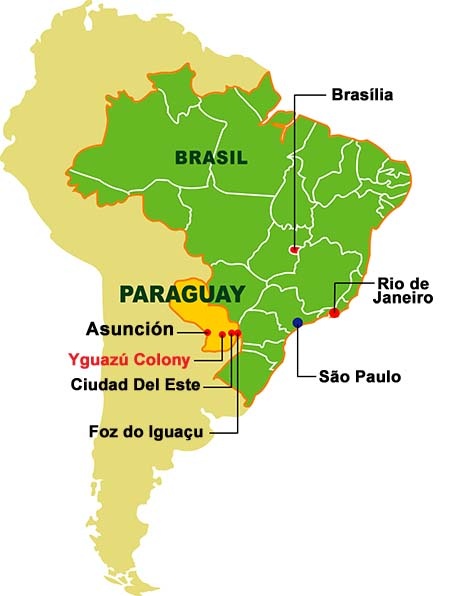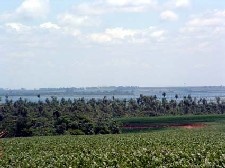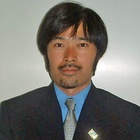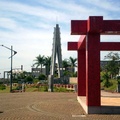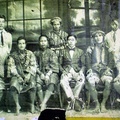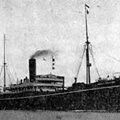From January to February of 2007, I took a trip through Paraguay and the northern region of Paraná. Though the main goal of this series is to bring to light the history and current state of Japantowns in Brazil, in this auxiliary chapter, I would like to include my own impressions of the Nikkei colony of Yguazú from my visit.
Foz do Iguaçu, famous for the Iguazu falls, is connected to Paraguay by a single bridge over the Paraná River. Once across this “Bridge of Friendship,” one arrives in the Ciudad Del Este, Paraguay’s second largest city. The city is called the “Hong Kong of the South America” due to the large population of Chinese immigrants (mostly from Taiwan) and its characteristic as a free port. Riding on the local bus for an hour along National Highway 7, which connects Ciudad Del Este with the capital, Asunción, one can get off at "Kilómetros Quarenta y Dos" (the 42 km point) and arrive at the Yguazú Colony, also refered to as the "Colonia Japonesa" (Japanese colony).
Japanese immigration to Paraguay began in 1936. Similar to the conditions in Brazil mentioned in previous chapters, the history of immigration into Paraguay was also filled with a growth in nationalism and anti-Japanese sentiment. The “Two Percent of Immigrants Restriction Law” (long-term settlers of applicable countries cannot surpass 2% of the population) implemented in 1934 suddenly decreased the allowed number of Japanese immigrants from 20,000 a year to 2,500 a year. This caused a rapid preparation for immigration into Paraguay starting with immigration from Brazil in June of 1936. In August of the same year, the first immigrants arrived from Japan and began to develop the La Cormena Colony in the southern region of Paraguay.
At first, due to the short preparatory time of the La Cormena Colony, the immigrants suffered many hardships such as political turmoil and major damages from raids by large hoards of grasshoppers. With the start of the Pacific war in 1941, Paraguay, along with Brazil, severed international ties with the Axis power countries, ceasing aid from Japan and further immigration. Japanese immigrants were deemed “foreign enemies” and Japanese language schools and young persons' associations were forced to dismantle. It is said that all of the Nikkei population of Paraguay was quarantined in La Cormena.
After such a tragedy, post-war Japanese immigration into Paraguay resumed in 1952. An immigration agreement between the Japanese and Paraguayan government was signed in 1959 and was taken to effect in January of 1960. The current Yguazú region was once deemed by the Paraguayan government as agriculturally suitable and is located in a triangular region created in between the three cities of Asunción, Encarnación, and Presidente Franco. In previous years, National Highway 7, which ran from Asunción to Brazil, was constructed through the area and much development was anticipated. From such a historical background, the Yguazú colony was created in 1960 and in August of the following year, the first settlers arrived. Since its creation, almost half a century has passed.
As a resident of the capital Brasília located in the Brazilian plateau, my first impression of Yguazú was overwhelmed by an intense heat when I got off the bus. I began walking along the stone paved road, which wasn’t there during my visit 10 years ago, toward the recently opened Fukuoka Ryokan (Japanese inn) under the blazing sun. There were no other pedestrians; probably due to the daytime heat wave. I asked a Paraguayan boy on a bicycle, who passed by me by chance, for directions in my Portuguese accented Spanish. He answered in Japanese, “Atchi, atchi (over there, over there).”

Picture 4-1: The Ootorii (Grand Arch) that stands in front of the Association of Japanese Descendants (photo taken by author in 2007)
In the ryokan , I met up with Mr. W, my guide for this trip. Mr. W was a staff member of a NGO in Japan and worked in the afforestation industry in the region. I was led by Mr. W on a visit to the the Nihonjinkai (Japanese Association of Yguazu) and was greeted in a friendly manner by the head of the secretariat, Mr. H. His fluency in Japanese and demeanor made me think he was an Issei (first generation). However, when I inquired, he told me he was a Paraguay-born Nisei (second generation). The first thing that surprised me in Paraguay was the level of use and fluency of the Japanese language in the second and third generations. Of course, there are Nikkei in Brazil who are similarly fluent in Japanese but their numbers are dwindling. Mr. H had such Japanese mannerisms that I felt like I was being greeted by a helpful, young section manager of a provincial city town hall in Japan. I can imagine the Nikkei of Brazil were like this some decades ago. Even so, according to Mr. H, the population of fluent Japanese speakers is decreasing every year.
According to the “Yguazú 2006 Census by the Japanese Association” which I received during my visit, the city has a population of around 9,200 and covers an area of 87,763 hectare (of which 10,000 hectare are submerge under the Yguazú River). Most of the land is farmland. It is estimated that there are around 250 Nikkei households and around 1,676 non-Nikkei households.
Next, I was shown around town in a car by Mr. O, a staff member of the Japanese Association. Though all the windows of the car were open, of course, it was still hot. Mr. O, who works at the Japanese Association during the day and goes to college in the evenings, spoke Japanese as fluently as the youth in Japan. In the city, there were facilities such as a city hall, agricultural cooperative, co-op supermarket, elementary school, Japanese language school, catholic church, kindergarten, education research establishment, cultural exchange center, medical clinic, police station, silo, milling factory, judiciary office, telephone company, post office, baseball, soccer and gate ball field, park, park golf field, pool, gasoline station, notary public's office, and city cemetery. I was told that the Japanese school runs up to high school and as a self-governing facility of a population of less than 10,000 people, it is very well established. Leaving the cozy town area, fields of soya bean, the major product of the area, spread all the way to the Yguazú River in the distance.
In the evening, I was once again accompanied by Mr. W to visit the Yguazú Taiko workshop. I have actually been to the Yguazú region twice before. My granduncle had lived in Yguazú as a staff member of the Immigrant agency and after retiring, settled down in the region and began cultivating grapes. Though my granduncle then moved back to Japan in his final years and passed away, his children still live in various towns in Paraguay. When I told Mr. W about this, he told me that the taiko workshop that we were about to visit coincidentally used to be my granduncle’s house. Mr. W chuckled and said, “It must be some kind of fate.”
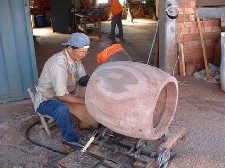
Photo 4-3: The making of the taiko drum shell at the Yguazú taiko drum workshop (photo taken by author in 2007)
The taiko workshop was founded in December of 2002 when two brothers of the S family, who were master taiko performers and makers, visited Yguazú. Currently, the workshop is run by a carpenter named Mr. I and other members involved in the drum making process. With the exception of the rivets, local materials are used to re-cover the leather drum tops and make the taikos and accessories. Though the drum shells are made from Paraguayan Cana Fito or Peroba wood, they say the drums have a deep, resonating sound that is comparable to that of Japanese keyaki wood (species of elm-like tree).
“Taiko in Brazil is very unique isn’t it? Here, our taiko production and choreography are all based upon traditional Japanese taiko,” Mr. S said as he took some time out of his work to chat. He and his brother moved to Yguazú in 2002 and are the newest residents in the area. In the evenings, practices are held in the annexed practice room of the factory. Though the sun was about to set, the young boys and girls were sweating in the heat as they played the taiko drums. Mr. S would walk around to each student and coach them with enthusiasm.
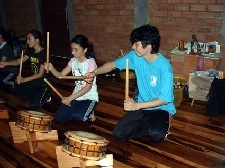
Photo 4-4: A scene from the taiko practice at the Yguazú taiko drum workshop. In the foreground, Mr. S is seen coaching the students (photo taken by author in 2007)
The current topic of interest in the Yguazú colony is the “Immigration of Tanabata.” Once a year since 1997, the “Expo Yguazú,” an agricultural produce trades fair, is held and at the 9th Annual Expo Yguazú held last August, a Tanabata (Star Festival) decoration was sent over as a gift by the Brazilian Miyagi Kenjinkai (Prefecture Association) and was decorated in the Japanese food corner. The Brazilian Japanese newspaper reported it as an “immigration of Tanabata decoration.” Last year, the Yguazú Taiko workshop undertook the re-covering of the leather drum tops of the taikos brought in from Belém, Brazil. In such ways, it seems exchange with the Brazilian Nikkei community has grown year by year.
Seven or eight years ago, the “Conceptualizing Yguazú Japantown: A Community of Culture and Craftsmen” was created to invite Japanese craftsmen to Yguazú so they could pass on their trade skills to the Paraguayan people in the area. According to Mr. W, this concept is starting to gain attention again. The sun sets, and as the sound of the taiko drums comes to a stop, the town finally escapes from the blazing heat. The town in which my granduncle settled down; I felt as though I saw one form of an ideal South American Japantown in this city surprisingly filled with Japanese spirit.
References:
The Association of Japanese Descendants Corporation “Yguazú 2006 Census by the Association of Japanese Descendants”
Federation of Japanese Associations of Paraguay “History of the Japanese Immigration in Paraguay”
http://federacion.hp.infoseek.co.jp/inmigracion/inmigracion.html
Federation of Japanese Associations of Paraguay “History of the Yguazú Colony”
http://federacion.hp.infoseek.co.jp/colonia/yguazu/colonia_yguazu.html
© 2007 Sachio Negawa


